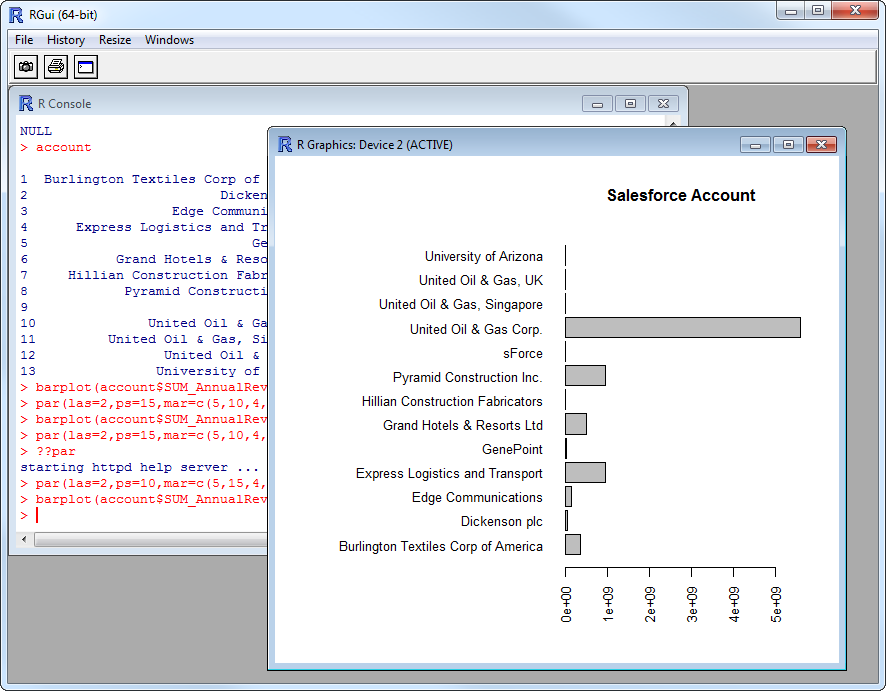Discover how a bimodal integration strategy can address the major data management challenges facing your organization today.
Get the Report →Analyze AlloyDB Data in R
Use standard R functions and the development environment of your choice to analyze AlloyDB data with the CData JDBC Driver for AlloyDB.
Access AlloyDB data with pure R script and standard SQL on any machine where R and Java can be installed. You can use the CData JDBC Driver for AlloyDB and the RJDBC package to work with remote AlloyDB data in R. By using the CData Driver, you are leveraging a driver written for industry-proven standards to access your data in the popular, open-source R language. This article shows how to use the driver to execute SQL queries to AlloyDB and visualize AlloyDB data by calling standard R functions.
Install R
You can match the driver's performance gains from multi-threading and managed code by running the multithreaded Microsoft R Open or by running open R linked with the BLAS/LAPACK libraries. This article uses Microsoft R Open 3.2.3, which is preconfigured to install packages from the Jan. 1, 2016 snapshot of the CRAN repository. This snapshot ensures reproducibility.
Load the RJDBC Package
To use the driver, download the RJDBC package. After installing the RJDBC package, the following line loads the package:
library(RJDBC)
Connect to AlloyDB as a JDBC Data Source
You will need the following information to connect to AlloyDB as a JDBC data source:
- Driver Class: Set this to cdata.jdbc.alloydb.AlloyDBDriver
- Classpath: Set this to the location of the driver JAR. By default this is the lib subfolder of the installation folder.
The DBI functions, such as dbConnect and dbSendQuery, provide a unified interface for writing data access code in R. Use the following line to initialize a DBI driver that can make JDBC requests to the CData JDBC Driver for AlloyDB:
driver <- JDBC(driverClass = "cdata.jdbc.alloydb.AlloyDBDriver", classPath = "MyInstallationDir\lib\cdata.jdbc.alloydb.jar", identifier.quote = "'")
You can now use DBI functions to connect to AlloyDB and execute SQL queries. Initialize the JDBC connection with the dbConnect function.
The following connection properties are usually required in order to connect to AlloyDB.
- Server: The host name or IP of the server hosting the AlloyDB database.
- User: The user which will be used to authenticate with the AlloyDB server.
- Password: The password which will be used to authenticate with the AlloyDB server.
You can also optionally set the following:
- Database: The database to connect to when connecting to the AlloyDB Server. If this is not set, the user's default database will be used.
- Port: The port of the server hosting the AlloyDB database. This property is set to 5432 by default.
Authenticating with Standard Authentication
Standard authentication (using the user/password combination supplied earlier) is the default form of authentication.
No further action is required to leverage Standard Authentication to connect.
Authenticating with pg_hba.conf Auth Schemes
There are additional methods of authentication available which must be enabled in the pg_hba.conf file on the AlloyDB server.
Find instructions about authentication setup on the AlloyDB Server here.
Authenticating with MD5 Authentication
This authentication method must be enabled by setting the auth-method in the pg_hba.conf file to md5.
Authenticating with SASL Authentication
This authentication method must be enabled by setting the auth-method in the pg_hba.conf file to scram-sha-256.
Authenticating with Kerberos
The authentication with Kerberos is initiated by AlloyDB Server when the ∏ is trying to connect to it. You should set up Kerberos on the AlloyDB Server to activate this authentication method. Once you have Kerberos authentication set up on the AlloyDB Server, see the Kerberos section of the help documentation for details on how to authenticate with Kerberos.
Built-in Connection String Designer
For assistance in constructing the JDBC URL, use the connection string designer built into the AlloyDB JDBC Driver. Either double-click the JAR file or execute the jar file from the command-line.
java -jar cdata.jdbc.alloydb.jar
Fill in the connection properties and copy the connection string to the clipboard.

Below is a sample dbConnect call, including a typical JDBC connection string:
conn <- dbConnect(driver,"jdbc:alloydb:User=alloydb;Password=admin;Database=alloydb;Server=127.0.0.1;Port=5432")
Schema Discovery
The driver models AlloyDB APIs as relational tables, views, and stored procedures. Use the following line to retrieve the list of tables:
dbListTables(conn)
Execute SQL Queries
You can use the dbGetQuery function to execute any SQL query supported by the AlloyDB API:
orders <- dbGetQuery(conn,"SELECT ShipName, ShipCity FROM Orders WHERE ShipCountry = 'USA'")
You can view the results in a data viewer window with the following command:
View(orders)
Plot AlloyDB Data
You can now analyze AlloyDB data with any of the data visualization packages available in the CRAN repository. You can create simple bar plots with the built-in bar plot function:
par(las=2,ps=10,mar=c(5,15,4,2))
barplot(orders$ShipCity, main="AlloyDB Orders", names.arg = orders$ShipName, horiz=TRUE)







